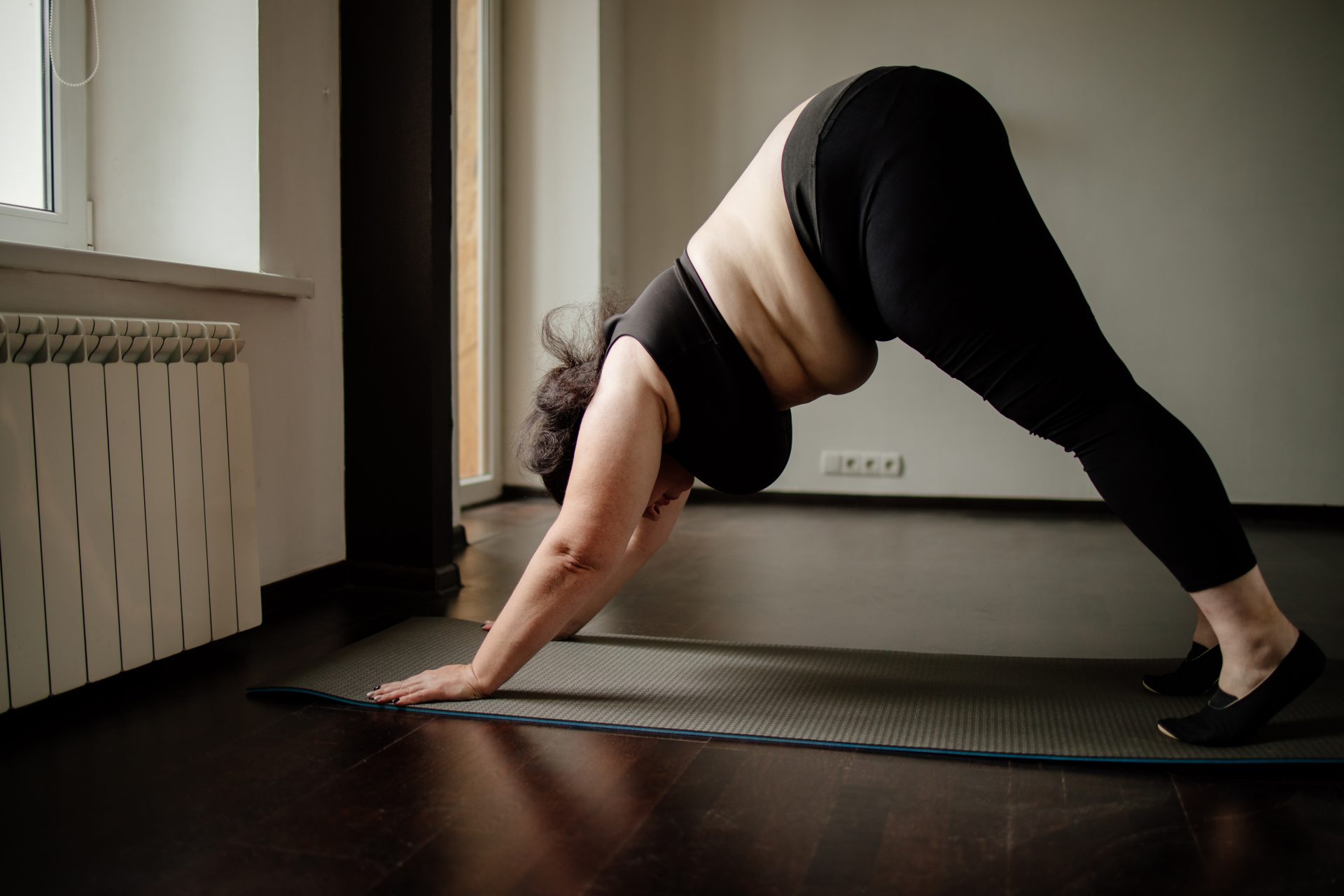Yoga stretches are great for everything from pain relief to stress relief, and they’re really easy to work into your day. Yoga instructor Donna Noble explains how.
Whether you’re feeling a bit overwhelmed by the thought of lockdown ending or are feeling sore from sitting at your desk for long hours throughout the working day, yoga can help.
However, the practice can feel intimidating to those who have never done it before. Plus, not everyone has the time to squeeze in a couple of 90-minute classes every week just to destress from a busy week. That doesn’t mean you have to miss out on what yoga can do for you. In fact, just by working some basic stretches into your routine, you can start to feel all the physical and mental health benefits the practice has to offer.
Donna Noble is a yoga teacher and the founder of Curvesomeyoga, an organisation that aims to make yoga inclusive, diverse and accessible for all. Here, she explains exactly why we should start incorporating simple yoga stretches into our day-to-day lives, and which to try first. There’s no better time than today, International Day of Yoga, to start.
You may also like
Yoga benefits: all the ways that yoga can improve your mental health
What are the benefits of yoga?
There are physical and mental benefits to yoga. First, it can “keep the body strong and supple”, as well as “increase flexibility” and “help with the realignment of the body”. All of these things can “help your body to achieve its full potential”, as well as protect it from injury when you’re engaging in other physical activities such as weight training and cardio.
But yoga is also very calming, and as a result it can aid sleep and even help to alleviate insomnia. In fact, according to the Sleep Foundation, when insomniacs perform yoga daily, “they sleep for longer, fall asleep faster, and return to sleep more quickly if they wake up in the middle of the night”. As Donna goes on to explain, this can help to reduce sleep deprivation and restore energy and vitality.

Yoga’s calming effects don’t just help with sleep – they can give your mental health a boost, too. Practising moves such as downward dog and warrior poses soothes soothes and centres the nervous system, “which in turn helps to relieve stress and associated issues”, such as low mood and anxiety. In addition, yoga helps you to get in touch with your body, teaching you to breathe fully, trust your body, and make you more mindful, Donna explains. All of this makes yoga a great thing to include “as part of your self-care practice”.
How often do you need to do yoga to feel the benefits?
The short answer is that “some yoga is better than no yoga”, says Donna, so even if you only find time to do 10 minutes of yoga stretches every day, you will still experience some of the benefits. In the short-term, yoga stretches may offer you a way to relax after a busy day, wind down before bed when you’re feeling stressed, or stretch out your aching muscles following an intense gym session.
Because of its huge calming effect, there’s no better time to practise some simple postures than during your work day, when stress levels are peaking. As part of Stylist magazine’s Work It Out campaign, Strong Women is encouraging everyone to take their Work 5-a-day, five scientifically backed breaks from your computer, with at least one break focusing on moving your body. So, try walking away from your desk for five minutes of gentle stretching and see how you feel.
Donna does note that if you want to really feel the full benefits, or you have mental or physical health concerns that yoga could help you to manage, you could try “doing yoga at least twice a week”.
You may also like
Stretching: 3 easy stretches to improve your flexibility
The best yoga poses for beginners
If you want to start working yoga into your schedule, Donna has a few simple poses and stretches that are great for beginners to try.

Child’s pose
Child’s pose stretches “the thighs, hips and ankles”, and it “is often performed to rest in between poses”, says Donna. This stretch is great for helping to “relax the body and the mind”, and so Donna suggests staying in position for as long as you like.
- Start out on all fours on the floor and then take your knees out as wide as your mat with your toes touching.
- Sit back so that your bum is resting on your heels.
- Stretch your arms forward and lower your chest and forehead to the floor.
- Let your entire body release down into the mat.
Mountain pose
“This forms the foundation of all standing poses”, according to Donna, making it a great pose for beginners. Mountain pose is really easy to do, too.
- Stand up straight with your feet placed wherever feels natural, either together or apart, and your arms by your side with your palms facing forwards.
- Press your weight into your feet and spread the toes wide.
- Engage your quads and abdominal muscles by pulling your belly button in towards your spine.
- Lift your chest and pull your shoulders down and back – you should feel the shoulder blades coming towards each other.
Hold this pose for between five and eight breaths
You may also like
How to do a downward facing dog correctly
Downward dog
Even if you don’t know much about yoga, you’ve probably heard of downward dog. Known and loved for its simplicity and the way it “strengthens and stretches the entire body”, it is one of Donna’s go-to postures, and in fact “is used in most yoga practices and classes”.
- Start on all fours with your wrists under your shoulders and your knees under your hips.
- Tuck your toes and press through your hands to lift your hips up off the floor.
- Pull your sit bones towards the ceiling as youdraw your belly button towards the spine and your torso towards the thighs.
- The aim is to get your heels down to the floor and your legs straight, although you can keep your knees slightly bent if you are a beginner or have tight hamstrings.
Hold this position for five to eight breaths
Follow @StrongWomenUK on Instagram for the latest workouts, delicious recipes and motivation from your favourite fitness experts.
Images: Getty
Source: Read Full Article